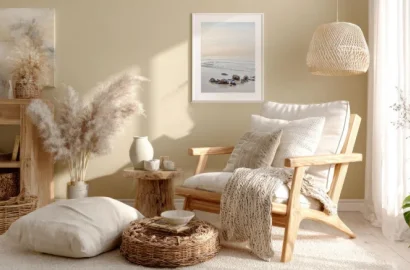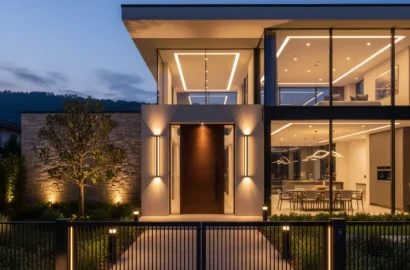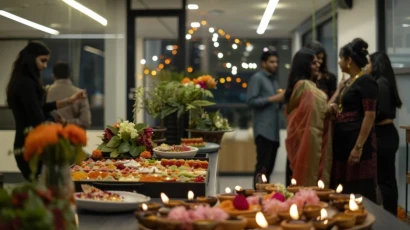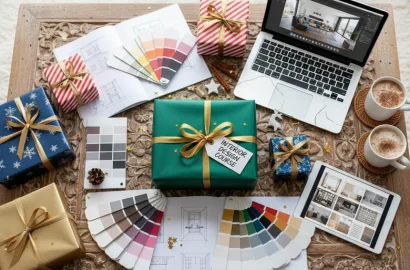How can you design an exhibition stall that makes an impact and attracts visitors? We’ve got the lowdown on everything you need to know about expo stall design to prepare you for your next trade show.
Your exhibition stall is more than just a display space–it’s your brand’s shop window. It’s where you showcase your products and services, make a lasting impression on visitors, and connect with potential customers and even business partners.
But it’s also much more than that.
Your stall serves as a physical embodiment of your company’s vision, values, and customer approach. A well-designed stall doesn’t just display its offerings–it tells the brand’s story in a way that effectively resonates with audiences.
When your exhibition stall is designed to guide visitors effortlessly through a delightful experience, you’ll not only capture their attention but also have the opportunity to build lasting relationships, enhance your brand’s reputation, and stand out from the surrounding competition.
However, if you’re new to exhibition stall design, where do you begin?
In this comprehensive guide, we’ll walk you through everything you need to know to create a positive and memorable visitor experience with your exhibition stall. From attracting foot traffic to facilitating exciting conversations and offering hands-on product interactions, we’ll show you how to design a stall that transforms visitors into satisfied customers and passionate collaborators.
Contents:
- Why exhibition stall design matters
- Key elements of exhibition stall design
- Practical tips for effective stall design
- Common mistakes to avoid
- Budgeting for your exhibition stall
- Trends in exhibition stall design for 2025
Ready to dive into exhibition stall design? Then read on for practical tips, trends, and how exhibition stall design can boost your customer and collaborator acquisition strategy.

Why exhibition stall design matters
From making the most of the space you’ve been allocated to boosting your brand’s offline visibility, let’s take a look at all the reasons why you can’t afford to neglect the interior design of your expo stall.
1. Maximizes space and functionality
The design of your exhibition stall will affect how well you can maximize the space available to you and how well the stall functions on the day of the expo itself. A stall that has been well-designed will take into account visitor movement, mitigate overcrowding, and provide the maximum amount of space to display products or demos. When designing a stall that optimizes space and functionality, think carefully about
- How you organize your products
- The adaptability of the space
- Accommodating interactive elements
- Providing adequate visitor seating
- Allowing space for tech installations
2. Attracts foot traffic
A well-designed expo stall will attract plenty of foot traffic and clearly differentiate itself from its surroundings. Visually compelling designs work particularly well in attracting visitors as they immediately draw the eye of people entering the space. Bright colors and clear branding are cornerstones of stalls that attract plenty of foot traffic, as are strategically placed lights, signs, and interactive displays that help to capture attention.
3. First impressions count
Exhibitions and trade shows are busy, loud environments. Your stall needs to make a positive impression quickly on potential customers to stand out from the competition.
The design of your stall can make a huge difference here. Organized and visually appealing stalls will be instantly more appealing to visitors than chaotic or cluttered spaces. In addition, stalls that communicate professionalism with clear messaging and attention to detail increase the likelihood of visitor interaction and help lay the groundwork for long-term business and customer relationships.
4. Boosts brand visibility
Your stall is a visual embodiment of your entire brand. A clear, cohesive stall design that fully aligns with your brand’s identity supports brand recognition efforts and increases awareness for visitors attending the trade fair. A well-designed stall uses colors, logos, well-placed signage, and graphics to display key messages visible from multiple angles. This detail in stall design increases the chances of passersby coming over to investigate your products and helps your brand stay in their minds after moving on to the next stall.

Key elements of exhibition stall design
Let’s run through the key trade stall components to consider to maximize visitor interactions and help you stand out from the competition.
1. Layout and floor plan
While the exact amount of floor space you are allocated at a trade fair is likely to vary from event to event, how you design the layout is critical for ensuring the maximum engagement from visitors and promoting a positive overall experience with your brand.
A carefully designed layout promotes easy navigation. This involves clear entrances, eye-catching displays, and allocated zones for product displays, interactivity, and presentations.
Modular stall design can help here too. Modular stalls enable you to swiftly and easily customize your stall for different events or to meet different visitor needs.
2. Visual appeal and branding
When we talk about visual appeal and branding in the context of exhibition stall design, we’re referring to the colors, logos, and design elements that visitors immediately recognize as belonging to your company.
A stall should try to accurately reflect the brand’s messaging in its visual design but also its identity and values. You can achieve this with bold signage and attractive (relevant) graphics that can be seen from a distance. It’s important to incorporate a cohesive visual theme as this creates an immersive environment for visitors, encouraging further exploration and engagement.
3. Furniture and fixtures
Functionality, style, and a cohesive aesthetic are key components of the furniture and fixtures you should use for your exhibition stall. As well as selecting attractive, modern furniture, you’ll need to consider your brand’s visual identity. Whether choosing display stands, counters, seating, or tables, be sure to select pieces that align with the company’s chosen visual approach.
Comfort and practicality are also key here. Select comfortable seating options that invite discussions or impromptu meetings, and use stands and counters that enable you to showcase products without overwhelming visitors. Light and easy-to-move furniture is particularly important in exhibition stall design. This is because light, adaptable furniture can be easily maneuvered around the allocated space and requires less effort to pack up at the end of the day.
4. Technology integration
Technology is playing an increasingly important role in exhibition stall design. From large screens and interactive touch panels to virtual reality (VR) and augmented reality (AR), immersive and cutting-edge technology can transform the experience of visitors to your booth, boosting engagement.
Some of the functions that technology integration allows include:
- Exploration of different products and experiences
- Ability to display key presentations
- Innovative brand interaction
Consider incorporating Wi-Fi, charging stations, and digital signage into your exhibition stall’s design as this will make the visitor experience considerably more convenient. When visitors have these tools at hand, they are likely to prolong their time at your booth, too.

Practical tips for effective stall design
Let’s dive into some of the simple steps you can take to make your exhibition stall stand out from the competition and provide an engaging experience for visitors.
1. Define your objective
When considering how to design and set up your exhibition stall, consider what you want to achieve on the day of the trade fair itself. For example, are you hoping to improve brand awareness? Showcase a new product or features? Make sales or generate leads? Or simply engage with a new audience?
Once you’ve identified the main objective behind setting up a stall at the exhibition, you are in a much stronger position to design one that will help you achieve your goal. If your goal is to showcase a new product, for example, you’ll need to ensure that you have the technology, facilities, and space that enable visitors to interact with it. Whatever your goal is for the exhibition day, keep it in mind while designing your stall as it will help ensure everything you do is aligned with your desired outcome.
2. Understand your audience
It’s important to have a strong knowledge of your audience, their preferences, and goals. This will help you design a stall that is attractive to the individuals you are hoping to connect with and facilitates their needs.
When designing your stall, consider the demographics of your audience. This includes age, gender, nationality, and occupation. If your target audience is predominantly students, for example, they will have different needs than working professionals. Possessing this kind of knowledge gives you a distinct advantage when designing your stall.
Next up, consider the behavior of your target audience. What is likely to draw their attention? Which of your competitors are they fond of? What kind of engagement best resonates with them? Experiment with visual, tactile, informative, and interactive options.
Finally, you’ll need to think carefully about your audience’s expectations when they arrive at your stall. Are they looking to be inspired or simply here for some information? Are they looking to purchase a service or try out different products?
When you’ve thought about who you are designing your stall for, you can tailor your stall to better meet their needs and expectations. When done effectively, your stall will be both more appealing to them and more relevant to their needs.
3. Focus on functionality
While the appearance of your stall is important for attracting visitors and standing out, functionality should always be a key component of its design.
Managing visitor traffic can be a challenge at large events so it’s important to plan out how you intend to support visitors in navigating with ease. You should also be mindful of how to store and display any promotional items, products, or samples. Try to display your materials so they can be easily seen by visitors and are accessible where necessary.
Finally, if you choose to integrate technology into your stall design, try out all of the screens, apps, and virtual tours beforehand to ensure they all function seamlessly. Remember, technology should enhance the visitor experience on the day, not complicate it.

Common mistakes to avoid
While an exhibition stall is a great opportunity to showcase your brand, product, or service, some common mistakes can quickly undermine its effectiveness. Let’s run through the most common errors and how to avoid them.
1. Overcrowding the space
Overcrowding is a common mistake made in stall design. Whether you cram too many products into your display, hang up too many signs, or squeeze in too much furniture, overcrowding will overwhelm your visitors and leave an unprofessional impression. An overcrowded space also means that visitors will struggle to find what they have come for and abandon your stall for another that is easier to access, navigate, and understand.
To avoid overcrowding at your stall, keep the layout as clean and simple as possible, with only your most essential items or products on display. Highlight key products or services and use minimalist, clearly written signs to guide visitors around your stall.
2. Poor lighting
Lighting is not only important for enabling visitors to see your products and displays but also creates a certain ambiance around your stall, boosting its appeal. While harsh lighting can negatively impact how your products are perceived, a combination of ambient, accent, and task lighting creates a balanced and inviting environment that facilitates visitor engagement. Be sure to highlight key products or areas of interest with focused lighting or spotlights and be mindful of how natural lighting works within the exhibition hall so you can adjust your stall lighting accordingly.
3. Ignoring visitor flow
Nobody wants bottlenecks, overcrowding, or visitor discomfort around their exhibition stall. However, visitor flow is a frequently ignored consideration of exhibition stall owners. This can become a huge problem, as when visitors feel trapped or unable to navigate the space easily, they are likely to leave quickly without engaging with company representatives or products. This can lead to missed opportunities on both sides.
To ensure your visitors can explore the stall in a natural and intuitive way, plan your layout carefully. Position products and displays in a way that nudges and guides visitors through the space while allowing them the freedom they need to explore. In high-traffic areas, be sure to allow extra room for interaction with products and people, and allocate space for visitors to stand still, too. When you design with these considerations in mind, the movement of people through your stall will flow smoothly.
4. Weak branding
One of the core reasons for taking part in an exhibition or trade show is to get your brand seen by potential customers, collaborators, and even competitors. It’s an opportunity to make a memorable impression and stand out from similar companies. For these reasons, your stall should clearly communicate your brand’s identity and its key messages. When branding is weak or inconsistent, visitors can come away unsure of your offering and what it can do for them. This creates a missed opportunity as visitors will fail to recognize your brand and you risk blending into the background.
To create strong branding for your exhibition stall, focus on the clarity of your message (or messages) and the visual consistency of its delivery. Stick to the same branding elements such as logo design and color scheme throughout the stall and ensure these fully align with the branding of the products on display. Finally, a good rule of thumb is to ensure branding elements appear at key visitor touchpoints like entrances, exits, displays, and all promotional materials.
How-to budget for your exhibition stall
These are our top tips for budgeting for your exhibition stall’s design and execution.
1. Set a realistic budget
Try to draft a budget that reflects both your desired objectives and any resource limitations you may have. These are the steps that will help you do this:
- Identify potential expenses
- Divide your budget into different categories and prioritize them
- Allocate funds for each category based on their importance
- Budget for unexpected costs
2. Look for cost-saving opportunities
You may think you are always looking out for cost-saving opportunities but have you considered these simple ways of stretching your existing budget and taking advantage of reduced rates?
- Reusing booth materials from previous events
- Bulk buying promotional materials
- Using in-house design and construction services
- Renting display equipment
- Exploring package deals for lighting, furniture, and branding
- Booking your stall spot early and being flexible with dates
Focus on high-impact areas
How can you make the biggest impact on potential customers and visitors to your exhibition stall, even with a limited budget? Think about which areas will provide the most return on your investment so that every penny you spend goes towards helping you achieve your goals. Areas for you to focus on which typically yield positive results include:
- Attention-grabbing booth design
- Professional-looking branding materials
- Interactive areas such as touchscreens or product demos

Trends in Exhibition Stall Design for 2025
With advances in technology and shifts in consumer behavior, exhibition stall design is evolving. We run through the latest trends so you can stay ahead of the curve this year.
1. Augmented and virtual reality experiences
Immersive technologies like augmented reality and virtual reality are going to become more commonplace at exhibitions and trade shows going forward. Tools such as VR headsets and AR-enabled devices will enable visitors to interact virtually with products and services before they commit to a purchase, helping businesses offer memorable, cutting-edge experiences that set them apart from the competition.
2. Modular stall design
The ability to adapt and scale an exhibition stall can be hugely advantageous for companies attending multiple trade shows. Modular stall designs are perfect for this as they typically feature customizable setups and easy reconfiguration with components that can be adjusted as necessary.
Modular systems enable you to tailor your stall to meet the specific environment and event you’re attending without compromising on branding, accessibility, or functionality. From ease of transportation and storage to creating dynamic, personalized layouts, modular stall designs are a budget-friendly and effective exhibition stall option that we’re likely to see even more of this year.
3. Sustainable materials
For companies looking to appeal to environmentally aware event attendees and align with corporate social responsibility goals, exhibition stalls made from sustainable materials will be a must in 2025. Some eco-friendly material options to consider when designing and building your stall include:
- Reclaimed wood
- Recycled plastics
- Biodegradable fabrics
- Low-impact finishes
The use of sustainable materials can enhance your brand image, demonstrate a commitment to sustainability, and help you stand out from the competition in the exhibition space itself.
Conclusion
As we’ve seen, designing an effective exhibition stall is no simple task. It requires strategy, creativity, knowing your audience’s needs, and considerable attention to detail. For those working within a limited time frame or budget, we’d recommend focusing on high-impact areas such as:
- Optimizing the layout for visitor accessibility and functionality
- Creating a strong visual presence that grabs attention and aligns with your brand
- Offering high-quality visitor interaction opportunities
- When these key elements are prioritized, your booth becomes a powerful tool for setting you apart from the competition and leaving a lasting, positive impression on visitors.
Head back to the AND Academy Design Blog for more articles like this one. Additionally, you can check out this commercial interior design project by AND Learner, Prathyusha Reddy, for inspiration!
Next Steps
In case you need further assistance, here are some resources to consider:
- Watch this session by Snehanshu Mukherjee, Founding Partner at T.E.A.M and Mansi Almadi, an Interior Designer at Studio Lotus
- Talk to a course advisor to discuss how you can transform your career with one of our courses.
- Check out our Interior Design courses – all courses are taught through live, interactive classes by industry experts.
- Take advantage of our scholarship and funding options to overcome any financial hurdle on the path of your career transformation.
Note: All information and/or data from external sources is believed to be accurate as of the date of publication.









